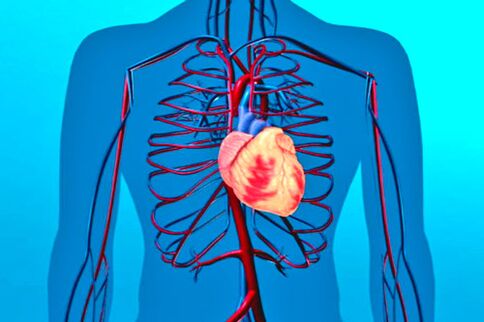
Risk factors for hypertension may vary depending on the type of disease. There are two types: primary or essential and secondary hypertension. The first type occurs many times more often than the second - it is diagnosed in 95% of hypertension patients, and its development is associated with three groups of factors: the general condition of the body, lifestyle and heredity. Secondary hypertension affects 5% of patients, and the risk factor for its development is various pathologies of special organs. Some factors can be controlled to reduce the risk of developing the disease.
Risk factors for primary hypertension
Essential arterial hypertension is a multifactorial disease; In some cases, it is impossible to determine the exact cause of the increase in pressure. The danger of the disease is that its symptoms are not immediately visible - the causes can gradually, imperceptibly impair health. Moreover, even in a latent state, hypertension increases the risk of myocardial infarction and stroke.
Health status
One of the reasons for the development of hypertension is the deterioration of the elasticity of arterioles - the small arterial vessels that transport blood to the capillaries. The condition of the vascular walls is affected by several factors:
- aging of the body;
- sedentary lifestyle;
- heredity;
- inflammatory processes in tissues.
Blood composition is also important for vascular health. Weakening of the circulatory system is primarily associated with diabetes mellitus. Blood glucose levels are regulated by insulin, a hormone from the pancreas. If its secretion is reduced or it cannot perform its functions normally, the vessels are stimulated by the sympathetic nervous system rather than dilated by insulin, which leads to an increase in blood pressure.
In addition to the condition of blood vessels, the risk of hypertension is also affected by body weight. Obesity causes the body to demand more blood, which increases the load on the heart and blood vessels. According to statistics, 85% of people suffering from this disease have a body mass index higher than normal. If obesity is combined with diabetes, it indicates a more complex metabolic syndrome - the destruction of vascular walls by cholesterol, triglycerides and glucose is a metabolic pathology that can lead to the development of atherosclerosis.
Another risk factor for the development of hypertension is sleep apnea - a pause in breathing for 10 seconds or more during sleep. This happens with severe snoring when the structure of the respiratory tract is completely closed due to pathology or other reasons. Each interruption of breathing is a strong stress for the body, and the pressure rises to 200-250 mmHg. Art. Constant attacks cause chronic arterial hypertension.
Life style
A bad lifestyle is a group of risk factors that are easy to control to prevent the onset of the disease. These include:
- an unhealthy diet that causes salt imbalance in the body;
- lack of physical activity;
- to smoke;
- alcohol abuse;
- chronic stress.
Excessive consumption of table salt is a symptom that unites most people suffering from arterial hypertension; Risk factors for this include both increased sodium concentration and low potassium content. Salts affect pressure from both sides: they cause blood vessels to constrict and retain water in the body. As a result, both the volume of blood and the pressure on the walls of the vessels increases. To prevent this, you need to eat no more than 5. 8 g of salt per day.
A sedentary lifestyle does not only lead to obesity. With a lack of activity, arrhythmia develops - the heart weakens and has to beat more often to pump the blood in the right amount, which increases the load on the entire cardiovascular system. During exercise, hormones that strengthen the heart muscle and relax blood vessels are produced, which leads to a decrease in blood pressure.
Regardless of whether tobacco is smoked, chewed or snorted, it raises blood pressure. The chemicals in which it is absorbed destroy the blood vessels. Nicotine has a complex effect on the circulatory system - it accelerates the heartbeat, increases the load on the blood vessels, narrows the lumen of the vessels. E-cigarettes do not save you from this negative effect, although the blood vessels will still be healthy if the carbon monoxide produced during the combustion of tobacco does not enter the blood.
Alcohol destroys the heart muscle, which causes an increase in blood pressure. It is recommended to drink 0. 5 liters of 5% alcohol per day for women, 1 liter for men up to the age of 65 and no more than 0. 5 liters after the age of 65.
Stress causes disorders in the work of the nervous system and causes a complex deterioration in the functioning of the body, which affects blood pressure. In addition, this is the background for the emergence of bad habits - overeating, smoking and alcoholism - which directly increase the risk of developing arterial hypertension.
Heredity

Family history is especially important when diagnosing hypertension; risk factors are usually the general environment (environmental conditions where the family lives) and behavior (lifestyle factors, probably passed from parents to the child), but primarily genes. The main factor in the development of arterial hypertension is heredity: there are genes that cause an increase in the synthesis of renin, a kidney hormone that increases blood pressure.
Hypertension is associated with heredity in 30% of cases, so it is important to monitor family history and record all diseases diagnosed in close relatives (parents, brothers and sisters, grandparents) - this will help to assess the risk of developing pathology and prevent it. If there is a risk, you should manage your lifestyle even more carefully.
Knowing all these factors, you can prevent hypertension, prehypertension, the development of a condition where blood pressure is on the borderline between normal and dangerous.
| state | Pressure values (mmHg) | |
|---|---|---|
| Systolic | Diastolic | |
| Norm | 120 | 80 |
| Prehypertension | 120–139 | 80–89 |
| Hypertension | >140 | >90 |
If you are at risk, it is recommended to measure the blood pressure twice a day: in the morning and in the evening, to detect the disease in time or to monitor your health in case of hypertension. to feel bad.
Risk factors for secondary hypertension
If primary hypertension develops against the background of a general deterioration of the condition of the body, and especially of the circulatory system, the risk factors for the development of secondary hypertension are specific diseases of the kidneys, endocrine glands, and the cardiovascular system.
Kidney diseases
The main kidney pathology that causes increased pressure is the reduction of the lumen of the renal artery. It can be congenital or develop at an older age. The main reasons for the intravital development of pathology:
- thickening of the smooth muscles of the artery - occurs in young women;
- atherosclerosis - in old age.
Due to this disease, the blood flow in the kidneys deteriorates, as a result, the secretion of renin and angiotensin increases. Together with the adrenal hormone aldosterone, they cause an increase in vascular tone and an increase in blood pressure. To treat pathology, the vessel is mechanically expanded and reinforced with a frame.
In addition, changes in hormonal levels can be affected by chronic pathological processes in the kidneys - pyelonephritis, formation of stones in the bladder, etc. The opposite reaction can also occur - hypertension causes diseases of the urinary system.
Adrenal tumors
Sometimes diseases of the adrenal glands cause an increase in arterial tone. These include the development of tumors that increase the production of hormones:
- Aldosterome - produces aldosterone. In addition to hypertension, this also causes an increase in potassium from the body.
- Pheochromocytoma - produces adrenaline, which accelerates the heartbeat and causes an increase in blood pressure. Additional symptoms include hot flashes, flushing, and increased sweating.
In both cases, the treatment consists of removing the adrenal glands.
Thyroid dysfunction
In the case of secondary hypertension, risk factors may be some diseases of the thyroid gland: diffuse goiter, nodular goiter. They lead to thyrotoxicosis - increased production of thyroid hormones. These biologically active substances regulate metabolism in the body; when they are in excess, the heart rate increases, which leads to an increase in blood pressure.
Take medicine
In addition to diseases, secondary hypertension can be caused by taking various drugs and other substances. These include:
- antidepressants;
- drops and sprays for rhinitis;
- anti-inflammatory drugs;
- oral contraceptives;
- corticosteroids;
- drugs - cocaine, amphetamines;
- hematopoietic stimulant;
- asthma medications;
- Antihypertensive drugs - can cause a sharp increase in blood pressure when stopped.
If hypertension is caused by drugs, you should consult a doctor and replace the drugs you are taking with analogues with fewer side effects.
Other risks of disease development
There are othersrisk factors for hypertension. Unlike diseases and lifestyle choices, they cannot be eliminated or controlled.
One such factor is race. Studies show that arterial hypertension occurs more often and develops more quickly in blacks than in whites, Hispanics, Asians, and others.
A person's gender also affects - men have a higher risk of hypertension, especially in adulthood and old age. Women are at risk during menopause and during pregnancy. The risk increases with age in both sexes. If until the age of 29, the probability of developing the disease does not exceed 10%, it reaches 50% at the age of 60-69.
Most of the world's population is exposed to hypertension risk factors at one time or another in their lives. In the United States, according to research, 9 out of 10 people get sick sooner or later, and in most cases it is associated with an unhealthy lifestyle. Quitting bad habits, getting regular checkups with your doctor, and monitoring your blood pressure are the best ways to stay safe.






















